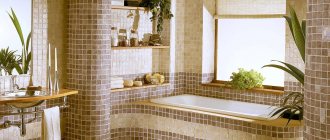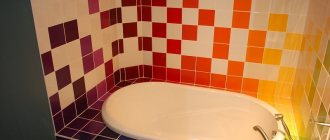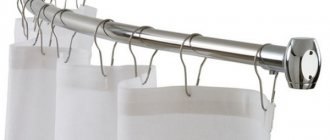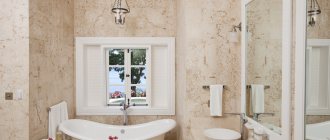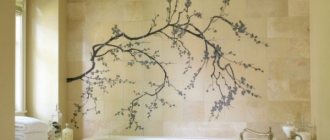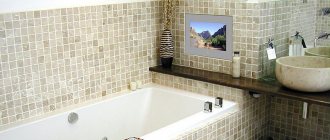The operating conditions for tiles in the bathroom are much more difficult than in other rooms. These rooms have constantly high humidity; the coatings have prolonged contact with water. Increased temperature should be added to the listed factors; in addition, safety precautions require special roughness indicators. Last but not least is design. Not everyone can produce products that fully meet high standards, but many Spanish ceramic tile companies are consistently ranked among the top five highest quality and responsible manufacturers.
Spanish bathroom tiles
All the beauty of Spanish tiles
A short list of famous Spanish companies of ceramic tiles for bathrooms
| Company name | Description of production activities and brief characteristics of goods |
Ceramicalcora | A relatively young, but already quite well-known company. Activities began in 1987 in the province of Castellon, the city of Alcora. Uses two-stage firing, which significantly improves the quality of products. Thanks to the use of the most modern equipment, the tones of the tiles exactly correspond to the specified parameters, the surfaces are perfectly smooth, and the plane and angles are fully maintained. |
Ceracasa Ceramica | Founded in 1984, tiles began to be produced in the early 90s. Ceramic tiles are made from red clay; since 1998, they began producing large-format tiles - the most complex products from a technological point of view. The company successfully uses rotary design technology, which has significantly expanded its design capabilities. |
MAPISA | From the very first day of its foundation (1973), the company has set itself the goal of producing world-class products, and the range is constantly expanding. Modern lines allow the production of more than 12 million square meters per year. In 2007, the company successfully joined the renowned industrial group HATZ. |
| LA PLATERA | One of the oldest companies that have managed to maintain high standards to this day. Constantly updating its production facilities, its design combines ancient traditions with modern fashion trends. |
Rocersa | Founded in 1977, production facilities are located in the city of Villarreal, producing more than 15 million square meters per year. Tile collections satisfy the most demanding consumers. The company has five prestigious awards for product quality. |
Mainzu | It began production activities in 1964, but closed in 1993. The reason for the closure was the need to completely modernize production equipment. Currently, it has all the capabilities to produce tiles of various sizes and styles; the company's management pays great attention to quality. |
| Grespania | The company's strategy is maximum availability of products to consumers with proper quality. Due to a flexible pricing policy, it achieves an annual increase in sales volumes. On the ceramic tile market since 1976. Some lines are considered elite, which allows you to create exclusive designs in bathrooms. |
| Christacer | Produces a wide range of tiles for interior and exterior use. The company was founded in 1970 and has an active marketing policy, due to which the number of clients is constantly increasing. Actively works with large construction companies. |
Azulejos Alcor | One of the oldest Spanish companies producing ceramic tiles, its first products were released in 1962. Due to constant work on expanding the range and improving quality, it managed to gain worldwide fame. |
Atlantictilesprojects | One of the youngest and most ambitious companies, quickly implements all the latest technological advances. The tiles have an ultra-modern design. High-performance equipment and optimal labor organization allow us to reduce selling prices, which is welcomed by numerous consumers of the company's tiles. |
Ceramicalcora tiles
Ceracasa Ceramica tiles
Cristacer Dream collection
Berna tiles (Azulejos Alcor SL)
Ceramic tiles LA PLATERA
La Platera Crema Marfil-Imperial
These are not all Spanish companies; we have listed only the most famous among domestic consumers.
History of Spanish ceramics
Historians and experts in the field of interior design are unanimous in their opinion that Spain had a tremendous influence on the emergence of most finishing and building materials made from red clay. It is known for certain that it was discovered in one of the provinces of the country by the monks of the monastery. They studied its properties, created the first products, and carefully preserved the composition recipe and ceramic production technology for posterity.
This discovery would later be attributed to the Arabs and Moors. Some historical sources indicate that red clay was brought to Spain by them. However, geological facts indicate the opposite - there is no other deposit of similar material, with exactly the same properties, in any area of the world.
Even then, more than 10 centuries ago, two types of ceramic products were produced:
- aristocratic - beautiful, durable - created for the nobility and sale in other countries,
- handicrafts - unattractive, short-lived, they were bought by the poor to decorate their houses.
Monks from the province of Castellon supplied small quantities of fired tiles to nearby countries located in what is now Portugal, Italy, and France. The fame of ceramics and its performance characteristics spread quickly, which became the reason for the expansion of small production in the monastery.
Wall cladding
Bathroom wall tiles should have one important advantage - moisture resistance. Ceramic products have a finely porous structure; therefore, without protective enamel, they easily absorb moisture, expand slightly, and then dry out.
Repulsing water droplets is a good quality for hallway or kitchen walls. In bathrooms, tiles from which water rolls off without lingering on the surface are much more valued. This property will ensure the hygiene of specific rooms for water procedures.
There are much fewer operational requirements for wall coverings. But it must have high aesthetics and a wide palette.
The interior of the bathroom will largely depend on the choice of color, pattern and combination of different tiles. You can successfully combine tiles of different formats, lay rectangular samples in a herringbone pattern, and square ones in a checkerboard pattern.
Features of the material
The main advantage of Spanish bathroom tiles is the material that underlies them.
Manufacturers use only red clay, which is mined in the province of Castellon.
It has unique physical properties, allowing you to create tiles with optimal performance and aesthetic qualities.
Floor and wall tiles undergo several stages of firing, strict control at each stage. When developing models, not only the technical requirements for it are taken into account, but also the latest trends in the world of interior design.
The production sites of the factories are equipped with innovative equipment, allowing the use of the most ancient recipe with a base in the form of red clay. The recipe was retained, but refined and improved. As a result, the consumer gets the best for his home, and manufacturers are among the top popular brands in the finishing and building materials market.
Features of wall and floor cladding with Spanish tiles
To save on repairs, prudent owners prefer to lay high-quality cladding material with their own hands. However, for those who are not experienced in the intricacies of imported products, it can be difficult to understand the degree of abrasion, functionality and labeling of tiles. It is important to know this so as not to confuse the floor tiles with what is used to cover the surface of the ceiling and floor.
- small mosaic tiles are produced within 1 – 5 cm in length and width (often they come mounted on a mesh, which must be embedded in cement mortar, and are offered in rolls);
- medium format - from 10x10 cm to 20x20 cm;
- large cuts go from 30x30 and above.
Porcelain tiles made in Spain are easy to lay on a prepared surface with your own hands, but problems arise at the cutting stage. The tile cutter will break quickly; you need waterjet cutting with a special machine. This is done by construction companies specializing in tiling.
Similar equipment can be found in construction hypermarkets. When purchasing, it is worth clarifying whether the tiles being sold can be cut, whether the service is paid or is included in the price of the material.
It is common to purchase a common material for all surfaces of the bathroom or shower, but this makes no sense. Imported tiles differ in performance indicators, and the higher the coefficient, the more expensive the repairs will be.
Spanish ceramics manufacturing technology
More than two thirds of the population of the province of Castellon work in the production of ceramics for all types of premises. This direction is the main source of income for the region. The main priority in the work of factories is high quality of products.
The production technology is thought out to the smallest detail. Products are divided into three types - glazed, single, double fired. All of them are manufactured using a certain technology. The recipe includes several main components:
- red, white clay,
- cement of the highest category,
- purified sand.
Single-firing Spanish tiles for the bathroom are an inexpensive material, but its technical and operational characteristics are inferior to its double-firing counterpart. Less time is spent on production - the tiles are not in a special oven for long, the technology involves single processing at high temperature.
Double firing requires going through many stages - drying, primary firing, after which it is cooled to a certain temperature, secondary firing.
Manufacturers value their reputation, regular customers, and strictly follow the technology and recipes for manufacturing products. When choosing ceramics from Spain, you can be sure of its quality and durability.
Types and characteristics of tiles from Spanish brands
The market for finishing materials for residential premises from Spain offers a huge number of collections for walls and floors, but all of them can be divided into several main types:
- tile,
- clinker,
- porcelain stoneware
Tile can be used for walls and floors due to its characteristics - dimensions (20*60 or 30*90 cm), resistance to temperature changes, humidity, and aggressive detergent components. The service life of tiles is at least 2 decades.
Porcelain tiles are recommended for finishing floors. It is durable, smooth, the number of pores in its structure is minimized, and is resistant to aggressive chemical elements and mechanical damage. Almost all porcelain stoneware manufacturers create edges along the edges of the tiles to prevent injuries during operation.
Clinker is a single fired tile with high strength and wear resistance. Such characteristics can be achieved using a special production technology – pressing followed by extrusion. The clinker is non-porous, with a dense structure, and an anti-slip coating on the front side. Its distinctive features are ease of installation, maintenance, durability, and reasonable price.
In addition, Spanish bathroom tiles are divided into 5 classification categories. The first is intended only for wall decoration. The second, third, fourth are suitable for both walls and floors. The fifth is the strongest, most durable, but it costs more.
Ceramic plate
Ceramic tiles are used to cover walls, ceilings, and floors, so many different colors and shapes are sold on the building materials and renovation market.
Durable and durable material
The following are considered the most basic:
- 15 * 15 square centimeters - small squares, mainly decorate the walls of bathrooms.
- 20 * 20 square centimeters - larger squares, used mainly to decorate the floor, ceiling, less often used on walls.
- 20 * 50 square centimeters - rectangles, which are just beginning to be used in bathtub design along with square samples, are often applied to walls.
There are both plain Spanish ceramic samples and various patterns and designs applied to them. A skillful combination of these two types of tiles in a bathroom design will help create an extraordinary and unique look.
Spanish tiles - an ageless standard
Ceramic tiles are also divided into:
- Matte - samples that do not have an additional coating, therefore they do not reflect sunlight or artificial light. The disadvantages include a greater degree of reaction to adverse external influences.
- Enamel - have an additional enamel coating, which protects them to a greater extent from the effects of water and high temperatures. Among enamel ceramic tiles there are also samples with a glossy sheen, as well as without it.
Matte finishes do not reflect light
The method of making tiles also divides them according to classification criteria. Such ceramic samples have the following names:
- Faience Spanish ceramic slabs - the basis for their production is faience, a porous material. The slabs have the same structure, and the range of color shades is given to them by painting with glaze.
- Majolica is a beautiful bright slab. It is covered with glossy enamel and many colored paints.
- Ceramic granite (porcelain stoneware ) - belongs to the class of high-temperature ceramics. It ranks first among durable, impact-resistant, durable tiles. Because of its characteristics, it is used as flooring in bathrooms and kitchens with hallways.
- Cotto is another slab that is distinguished by its ability to withstand the adverse conditions of bathrooms and remain in its original condition. It has a porous base and a matte surface.
- Clinker is also often used for flooring. Characteristics include waterproofness and fire resistance.
The demand for it is growing every day
This will be interesting to you: REVIEW: Kitchen floor tiles: 150+ Photos of the secrets of beautiful design
Pros and cons of Spanish tiles
For several decades now, ceramics have been the most popular for finishing bathrooms. But it has advantages and disadvantages that should be considered when choosing. The advantages include:
- number of collections, colors, design solutions,
- possibility to choose structure, shape, size,
- preservation of aesthetic, technical qualities,
- long service life, easy maintenance,
- moisture resistance, corrosion prevention,
- resistance to chemical components, high temperature.
Aesthetic data is directly related to technical data. In the assortment you can find the variety, type that is needed for finishing a specific room, taking into account the characteristics of its operation. For example, majolica has a porous base and a smooth glossy front surface.
Cotto - with a matte finish, excellent reliability indicators, even if the room humidity is high.
The faience variety can be painted, which expands design possibilities when decorating the interior and allows you to change the style if necessary without financial costs. Clinker and porcelain stoneware can be glossy or matte; the second option is heavier, but its service life is longer.
The only disadvantage of bathroom tiles from Spanish manufacturers is the cost, but if you compare it with the service life, the disadvantage becomes an advantage.
Product selection: what to look for?
Modern bathroom wall tiles, available at an affordable price, are available in a wide range. When purchasing ceramic wall tiles for the bathroom, you should consider:
- consumer qualities;
- color scheme of the room;
- tile size;
- style orientation;
- tile texture.
Why do customers decide to buy large format tiles? When used, a minimum number of joints are formed, which ensures the visual integrity of the surface and similarity to a monolithic finish. In addition, this material allows for quick installation.
Practical advice for choosing
There is no doubt about the quality of tiles for finishing walls or floors in a bathroom made in Spain. When choosing, you should take into account the following parameters - texture of the front and back surfaces, color, type of coating (glossy or matte), texture, geometry, size, shape, technical indicators.
It is necessary to take into account the abrasion coefficient. It is indicated in the accompanying documents of the party. Tiles with a PEI I coefficient are suitable for bathrooms. In addition, the load resistance criterion is important - sufficient thickness, moisture absorption level - above 5%.
The class indicates the ability to withstand sudden temperature changes and resist destruction under the influence of chemical reagents included in detergents. The best option is A or AA.
The surface of the tiles cannot be slippery. This factor is determined by the friction coefficient - the indicator should be R10.
It is necessary to check the geometry of the tiles. It is better to do this in a practical way - fold two tiles from the package with the front sides. The surfaces should fit tightly to each other, the edges should not go beyond the boundaries.
Aesthetic data is no less important than technical and operational data. When choosing, a reasonable question arises: should you prefer a matte or glossy surface? Designers are confident that a matte surface looks more expensive, creates a unique interior, looks natural, and is easier to care for. But you need to start not only from the advice of professionals in this field, but also from your taste preferences.
Bedroom and living room
Many people like the Spanish style in architecture and interior design because it allows you to combine deliberately rough surfaces and light, elegant designs. The walls are usually covered with rough plaster and then simply whitewashed with lime. The living room and bedrooms are finished in this way. There are many textures in one interior. Only country music can combine all this into one harmonious picture. Therefore, its characteristic features must be present in everything.
Plaster on the walls, rough wooden beams on the ceiling are the defining elements of the Spanish style Source yandex.net
The floor has stone or ceramic tiles. Since these are cold materials, you can throw a woolen rug under your feet, the color of which matches the color of the decorative accessories. The use of broad-leaved wood is allowed. Such textures combine very well with the main palette and help create homeliness.
The floor can be wooden, its color should match the color of the wood on the ceiling Source southcoastarhitects.com
The stone is also actively used to create original decor. In Spain in the Middle Ages, due to a shortage of wood, it was the main building material. And even if new houses are now being built using modern technologies, stone is always present in the decoration of the exterior and interior.
Rough stone as part of the original authentic decor Source comfortoria.ru
Stakes are required on the windows. They are the best protection against the scorching heat of summer. Their installation helps to emphasize the chosen style in the best possible way. The shutters can be left open, or they can be covered with textiles of a bright rich color. In both the first and second options, the atmosphere will be soft and very comfortable.
Shutters on the windows perfectly emphasize the Spanish style in the bedroom interior Source moydom.ru
Furniture is made of wood or metal. She is big and massive. The upholstery of the soft group is usually made of dark-colored materials (red, burgundy, brown). Such objects look advantageous against the background of plastered and whitewashed walls.
Furniture colors characteristic of the Spanish style Source adelaparvu.com
See also: Catalog of companies that specialize in interior redevelopment of houses and design of country cottages from scratch
If you choose a sofa and armchairs upholstered in brown leather with straight backs to equip the living room, place a wooden sideboard with glass doors along a free wall or attach open shelving to it, place your favorite dishes on the shelves in rows, you will be able to create the desired atmosphere.
Cozy, homely warm atmosphere Source cynthiabennett.com
The heart of the bedroom is a huge comfortable bed made of wood or wrought metal with a canopy made of transparent tulle or an open bed with a massive headboard. At her feet there is an ottoman, on the sides of the cabinet, instead of a wardrobe, there is a chest of drawers made of rosewood or teak.
Classic Spanish bedroom design Source southcoastarhitects.com
The Spanish interior will not look complete if it is not possible to emphasize its bright character. The easiest way to do this is by placing a large number of different decorative items in the living room and bedroom. These can be forged chandeliers, candlesticks, products made of multi-colored ceramics with traditional Mediterranean patterns, textiles from the same series.
Accessories set the mood Source pinimg.com
Pottery and tapestries that match the style are suitable as decorations. When it is not possible to hang them on the wall, an artist is called in Spain and he paints picturesque pictures on the walls. The finishing touches are live plants in ceramic pots, floor vases to complement them, mirrors in original frames. You can throw homespun cotton rugs on the floor.
Vases, paintings, pottery, forged metal candlesticks - a complete set of decorations for interior decoration in the Spanish style Source southcoastarchitects.com
Traditionally, bedrooms are located in the back private part of the house, and living rooms are located in front. The “public” space is revealed, but not completely. One room smoothly flows into another. Large open arches are used to create this effect. They can appear between the living room and dining room or between the dining room and kitchen.
Open arches are the third defining feature of style Source yandex.net
Popular Spanish producers
The Russian market offers a large selection of materials in this category, made in Spain. One brand can specialize in the production of one or several types. Products from the following manufacturers are in demand:
- Absolut keramika cobsa,
- Aparici,
- Ape ceramica,
- Aranda,
- Azahar,
- Azteca,
- Ceracasa.
Absolut keramika cobsa
Absolut keramika cobsa is characterized by a stylistic solution in the spirit of country, Victorian or European from the beginning of the last century. The dimensions of the tiles are smaller than average, but the technical and performance indicators are high.
Aparici
Products from the Aparici factory meet environmental safety standards; special attention is paid to this aspect during production. Even a small batch will be provided with international and Russian certificates.
Ape ceramica
Ape ceramica products belong to the elite class and cost accordingly. The assortment includes dozens of collections with aesthetic and technical characteristics characteristic of the category. When developing the design, the latest trends in the world of interior design are taken into account. The consumer will have to choose from the fashion collections of Lord, Allure, Carpicho, Siroco, Ryad and others.
Aranda
Aranda is a large manufacturer. The range includes a wide selection of sizes and colors. Products are produced on high-tech lines with innovative equipment.
Azahar
Azahar is a young brand that has gained popularity among consumers in a short time. The company takes a responsible approach to the quality of products already at the stage of selecting the source material.
Ceracasa
Ceracasa are tiles with prints on the front side, in bold colors. Choosing this brand guarantees excellent results, both aesthetically and technically.
In addition to the listed brands, products from other manufacturers from this country are supplied to the Russian market - Porcelanosa, Fanal, La Platera, Pamesa.
Benefits of bathroom tiles
Spanish tiles for bathroom decoration are considered the standard of quality and beauty, due to their excellent properties. This is exactly the case when the rejects do not end up in packaging. Defects do not go on sale, no matter how expensive it may be for companies specializing in the production of piece cladding.
The main advantages of Spanish collections for bathrooms:
- An environmentally friendly material that uses only natural raw materials (clay) with a slight inclusion of synthetic pigments and decorative chips.
- It has excellent performance characteristics; provided that all installation recommendations are followed, the coating of walls, floors and ceilings can not be changed for decades.
- It’s easy to find several options based on external parameters to implement original ideas and all kinds of stylistic solutions.
- A surface with such cladding will look stylish and fashionable for a long time, since the process of its production is constantly being improved and the design is updated.
- Spain is actively implementing innovative solutions to maintain its leading position in the global market. At the same time, the traditions of predecessors, who started with small handicraft production and strived to improve all the technical characteristics of ceramic tiles, are highly valued.
- The unsurpassed design reflects the national flavor of southwestern Europe, with its incredible color variations and fantastic designs.
- High-quality material made in Spain has a high strength and density coefficient.
Thanks to this, the country successfully competes with other companies that produce easily crumbling material.
- ceramic baseboard;
- side;
- decorative and functional inserts with hangers and soap dishes;
- linear fragments for forming frames.
Collections are produced with small mosaic fractals, standard sizes 20x20 cm and large cuts - within 50x50cm. Large format tiles are mainly used as inserts and decoration.
Price of Spanish bathroom tiles
The cost depends on the brand, size, color and stylistic design of the tiles, their quantity in the package, supplier, seller’s pricing policy and other market factors. You can buy tiles for 1,500 or 3,000 rubles per package.
Before making a choice, it is better to familiarize yourself with the entire range, with all the offers on the market. Inexpensive products are offered by the brands Azahar and Aranda. Tiles produced by the factories Ape ceramica and Absolut keramika cobsa have a higher price, but their lines also have budget offers.
Where to buy universal cladding and find out the cost
Elite finishing cannot be cheap; quality and beauty are paid for by those who know how to appreciate exclusive design, the ecology of personal space and the reliability of finishing.
The best imported collections are traditionally updated; the classics remain unchanged from Aparisi and Ceramica, Novogres or Pamesa. You can choose amazing combinations of patterns and plain ceramics, as well as tastefully combine matte, glossy and mirror tiles.
Phototiles can be used not only to cover the wall above the jacuzzi, but also to modernize the floors. The “bottom” with sharks or a coral reef looks very impressive.
There is no doubt about the quality of Italian manufacturers such as Valverde, Tilegres or Saloni; it is more important to choose the type of coating wisely. In the regions, branded products can be ordered directly through the manufacturer’s official website.
Stylish examples of bathroom decoration
The bathroom can be tiled partially or completely. With its help, it is easy to zone space, emphasize winning moments, and mask shortcomings.
First of all, you need to decide on the style, color scheme, taking into account the features and dimensions of the room, and the method of laying the tiles. Designers recommend the following styles:
- eco,
- high tech,
- Scandinavian,
- Provence,
- classic.
For eco-style, tiles are suitable, the front surface of which imitates natural materials - stone, wood. You can zone the space by combining both types of surfaces, or by creating a mountain landscape, forest, or sea on one of the walls.
This approach to interior design is not only relevant at the moment, but also recommended by psychologists - it is in the bathroom that it is easiest to get rid of stress after a long and difficult day.
High-tech is characterized by urbanism and constructivism. Designers either combine borderline shades or play with contrast. A popular solution is when communication lines are emphasized. Strict geometry allows you to visually expand the space. A skillful combination of colors or their shades enhances the effect.
Scandinavian style is a combination of minimalism and comfort. To create it, it is recommended to use tiles in one color, but decorate part of the space with printed tiles, and part with plain ones. Cool shades are welcome - white, light gray, ecru, beige, and similar ones.
Only the floor can be dark, but the tiles must imitate a natural surface, optimally stone.
Provence is close to the classics, but each style has its own nuances. For Provence - simplicity, absence of complex lines, maximum comfort and naturalness. Classic is aristocratic, visually expensive, pretentiousness is unacceptable. In addition, in many aspects it is close to the high-tech style, which makes it relevant.
General requirements for finishing are maximum light, absence of heavy, dark elements. If you are not sure that you will be able to choose the right tiles to create a certain style on your own, then you should turn to professionals for help.
Developing a design project for a small room is not financially burdensome and will not require significant additional costs.
The modern market offers a wide selection of tiles. Professionals in the field of finishing work prefer Spanish. And this is not surprising, because it is characterized by high technical, operational and aesthetic data, the range includes budget and luxury options, manufacturers from this country offer a large number of diverse collections.
Bathroom design - photos, design ideas 2020
This year, the variety of fashion trends in bathroom design is greater than ever. This is because the concept of trends in the interior takes on a deeper meaning. Individuality and the general idea come to the fore.
Thanks to the improvement of production technologies, much attention is paid to the texture of elements. The richer and more original the tile treatment, the more interesting and noble it looks. Increasingly, when choosing ceramic tiles, you need to focus on natural motifs, which imply not only natural colors, but also the corresponding pattern and texture. The trend for wall and floor coverings in vintage style remains relevant.
A total turn to naturalness does not mean that such an important area as the bathroom will lose its individuality and become another boring variation with a restrained finish. New collections with bright colors and non-trivial decor appear from the best manufacturers of ceramic products with the same regularity.
As usual, samples of the most refined and stylish series are primarily created by Spanish and Italian brands, which have long been famous for their delicate taste and high quality. By looking at our photo selection, you can clearly see examples of current bathroom interiors.
Spanish collection Pamesa Soul
The combination of light color and unobtrusive lace pattern visually increases the precious space of the bathroom. The interior looks especially harmonious due to the noble matte surface of the tiles.
The contrast of the monosyllabic base tiles and the original decor helps to correctly place accents and highlight the desired areas in the room. The complex pattern of elements plays with perception and creates an interesting visual effect of depth.
The unusual voluminous relief, imitating a honeycomb pattern, is definitely the strong point of this collection. The feeling of three-dimensional space is enhanced by the use of large-format elements and a reduced number of seams in the bathroom design.
Spanish collection Ceranosa Samarkanda
Patchwork, which is confidently winning fans, successfully adapts to any room. A patchwork pattern of squares with floral patterns is laid out in a whimsical mosaic in a relaxed oriental style.
The main tile supports the decor. Despite the contrast in color of the elements, the patterned texture of the base allows them to be intelligently combined and harmoniously combined, focusing attention on the necessary details.
Spanish collection ITT Ceramic Gaudi
Thick rich colors look no less noble than their modest pastel competitors. The design of this bathroom is modernized not only by the rich palette of tiles, but also by the texture options: glossy with light streaks and a voluminous floral pattern.
Not everyone can decide on a bright monochrome interior. Therefore, the cladding can be diluted with a softer and more neutral shade or decor with a contrasting pattern. Depending on the prevailing color, it can be used not only in spacious restrooms, but also in small bathrooms.
Spanish collection Navarti Azur
A ceramic interpretation of the traditional Capiton carriage screed is one of the new products that is quickly gaining popularity. To maintain stylistic consistency, this decor is combined with an aristocratic marble background.
Spanish Navarti Blade Collection
The same French capitonné can look even more delicate when using a pearl-gray palette. To create a unique atmosphere of sophistication, basic and decorative tiles are combined with borders, inserts and plinths designed in a classic style.
Spanish Newker Mediterranean collection
The rich history and culture of the Mediterranean serves as an inexhaustible source of inspiration for designers. The fusion of European, Arabic and antique motifs reflected in the patchwork panel represents a special mix of patterns and ornaments.
The main colors of the collection are sunny shades. Basic milky white and beige tiles fill the space with light and air. And the hexagonal pattern of small elements of different shades creates a feeling of a unique play of sunbeams.
Spanish collection Goldencer Celine
Decorating bathroom walls with tiles with a floral pattern is considered the best basis for creating the Provence and shabby chic style that is in demand today. To create a cozy atmosphere, it is better to use pastel colors, floral patterns and tiles with a pleasant fabric texture. This situation will remain relevant regardless of the turns of changing fashion.
Spanish Ibero Perlage collection
Who would have thought that shades of sea wave and mother-of-pearl, Mediterranean patterns, as well as volumetric tiles together create the perfect interior in the Art Nouveau style. In reality, success lies in the precise contrast of turquoise and pearl colors, matte and glossy textures, three-dimensional effect and absolute smoothness, slightly seasoned with patchwork.
To push the boundaries of space, it is better to use a lighter color scheme and a glossy surface. This design of the floor and walls reflects light better, which means it looks advantageous even in rooms with a modest area.
Spanish collection Pamesa Atrium Deneb
Against the backdrop of numerous eco-collections and laconic series, bathroom designs with classic lines of ceramics look especially advantageous. The Victorian pattern in this case does not look old-fashioned due to the use of large-format tiles and a counterweight in the form of decor imitating mosaics.
These same glossy mosaic elements seamlessly interact in spacious restrooms and small bathrooms, finished in Art Nouveau style, where they are combined with geometric lines and the natural pattern of natural marble.
Spanish Pamesa BrickWall Collection
The deliberately daring effect of simple brickwork is achieved through different shades of gray and the texture of torn stone. Avoiding excessive harshness and introducing stylish eclecticism into the interior is achieved by zoning the room and using a monochromatic layout.
The beige palette makes the design much lighter and airier, but even in this case it is worth combining a brick-style wall with a simple base surface. Like, for example, “hog” tiles to look like brick.
Spanish Newker Gala collection
Pleasant beige-peach tones are universally suitable for cozy family bathrooms and bathrooms in hotel complexes. The perfectly smooth glossy surface of the walls and shimmering mosaic inserts create a light feeling of glamorous chic without frills.
Spanish collection Mainzu Etrusco
The long-vanished Etruscan culture had a great influence on Europeans and left an indelible mark on the art of the Mediterranean. Their unusually delicate and thoughtful ornaments are considered masterpieces to this day. Laying tiles that replicate beautiful ancient patterns is a great way to add sophistication to your bathroom.
Spanish collection Navarti Agora
Stylizing the tiles to look like carriage upholstery in beige and coffee tones creates a lasting feeling of royal chic. The three-dimensional glossy surface of the walls and the harmonious marble flooring will indeed look organic in some palace, but this collection will be no less appropriate in an ordinary city apartment.
Spanish collection Mainzu Legno
Just looking at the photo you can understand that this line represents noble vintage in its purest form. The eye-catching wall tiles look like a mosaic made from pieces of old wood. As if covered with patina and paint residues, it brings a significant amount of comfort and a piece of history to the interior.
Spanish collection GayaFores Varana
Thanks to the increased size of the parts and the voluminous wave-like decor, stylized marble tiles look solid and modern. This series is devoid of pomposity and kitsch. There are only pure colors and a smooth, pleasant-to-touch surface.
Italian collection Alta Ceramica Alterna
The wide possibilities of the sensual and slightly playful Italian collection are fully revealed thanks to the cute floral panel, light mother-of-pearl shine, as well as elements of aged and eroding walls.
The design of a bathroom can be complemented by mosaics that are harmonious in color and texture, but can fully exist without it. The palette consists of pink-beige and silver-blue shades.
Spanish collection Pamesa Nature
Another way to create an interior that is timeless and timeless is a sophisticated series in pastel colors, complemented by patterned decor. Thanks to a competent selection of shades, floral and lace panels organically coexist next to each other and can also be complemented with shimmering mosaics.
Spanish collection Pamesa Agatha 25×50
A rich and rich collection replete with bright colors. It is in this playful charm that lies the secret of the extraordinary love of buyers for the series. The model range captivates with a variety of decorative elements and a rainbow palette of colors.
It is worth noting the unusual texture of the tile: stripes and drops of paint are not just painted, they are voluminous and are additionally highlighted by a smooth light-reflecting glaze, which creates a unique three-dimensional effect.
Lovers of a cheerful interior can choose multi-colored elements and mix them together to create a cocktail of colors. Due to the thoughtfulness of the details, such experiments do not cause fear. And the curiosity of researchers of the design possibilities of the collection will be rewarded with an excellent result.
Spanish collection Pamesa Camden
Sober and elegant ceramics, stylized as classic wallpaper with silk-screen printing, look a little bourgeois, but at the same time fit well with the traditions of the Russian nobility. The beauty of this tile is so obvious and piercing that it spreads a flair of sophistication to the entire environment.
Spanish collection Rocersa Soul
Despite the restrained palette, the next masterpiece of the Spaniards is very eclectic and this is precisely its main advantage. Elements made in completely different styles combine surprisingly well with each other. Depending on the chosen combination, the tiles will “play out” in a classic interior, as well as a room decorated in the spirit of Provence, Art Nouveau or loft.
Spanish collection Pamesa Agatha 20x20
Continuing the mischievous contradiction with the newly emerged eco-design trends. The Spaniards created not only bright, but also small-format tiles that are rarely produced today. Like previous creations of the brand, all elements fit perfectly together and can act in tandem with some previous collections.
The tiles have a textured surface with clearly visible patterns of stars, moons, flowers and hearts. The decor in some places is similar to a children's applique. This design in the bathroom will appeal to married couples and energetic young people.
Italian collection Alta Ceramica Affreschi
Unlike its predecessors, where the mosaic background served as only one of the decoration options, this series puts the pattern of small details in the first place. The design concept is completed to the finest detail by elaborate antique panels and patterned inserts.
The idea of the collection is inspired by the era of the greatest prosperity of Ancient Rome. The marble pattern used in the base, vintage borders and relief plinth are perfectly suited for decorating a majestic interior.
Return to list
